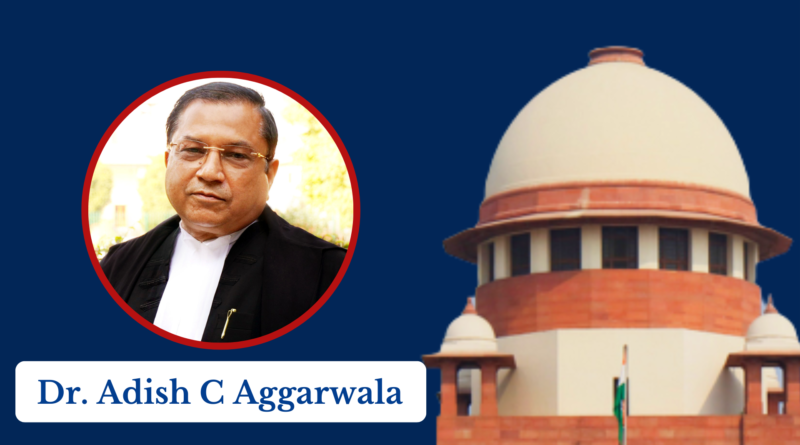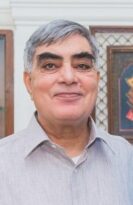A Legacy of Sound & Fury: A Law Leader’s Candid Reflections on The Chief Justice’s Tenure
(Judicial Quest News Network)
In a recent open letter dated November 14, 2024, Dr. Adish Aggarwala, former President of the Supreme Court Bar Association (SCBA), delivered a candid critique of the tenure of the outgoing Chief Justice of India (CJI)Justice DY CHandrachud. His reflection comes on the heels of a stirring remark by the CJI during the convocation ceremony of JSW Law School in Bhutan, where the judge pondered, “How will history judge my tenure?” and “What legacy will I leave for future generations of judges and legal professionals?”
Aggarwala, in his letter, acknowledges the CJI’s efforts but casts a critical eye on his leadership, questioning whether the public and legal community will remember him for more than just his flair for media engagement and ceremonial acts.
Close Quarters with the Chief Justice
Aggarwala’s tenure as the SCBA President began in May 2023, and over the course of his term, he worked closely with the CJI, navigating the complexities of judicial leadership, bar affairs, and the intricacies of legal governance. As President of the SCBA, Aggarwala had regular interactions with the highest offices in the country, from the CJI and the Supreme Court Judges to the Union Law Minister and Delhi’s Chief Minister. He describes himself as an apolitical leader, committed to advocating for the Bar and balancing the interests of lawyers, especially those from humble backgrounds, in maintaining harmony between the Bar and the Bench.
However, despite his initial admiration for the CJI’s commitment to modernizing the courts and his advocacy for individual rights, Aggarwala says he grew disillusioned with what he perceives as a leadership more focused on appeasement, media-driven initiatives, and personal recognition than on real judicial reform.
Strained Relations Over Case Allocations
Aggarwala’s first major confrontation with the CJI occurred over a letter written by former SCBA President Dushyant Dave in December 2023, which expressed concerns over the shifting of politically sensitive cases within the Supreme Court. After being summoned by the CJI to discuss the issue, Aggarwala was asked to support the CJI’s right to move cases and to publicly criticize Dave. While Aggarwala maintained that the CJI had the legal right to shift cases, he refused to use his position as SCBA President to criticize a former colleague.
Despite this, Aggarwala later complied with the CJI’s request, issuing a letter on his own letterhead that praised the CJI’s administrative streamlining. However, he recounts how the CJI later admitted that the situation had been defused without the need for more drastic actions.
Controversial Senior Advocate Designations
One of the most contentious issues during Aggarwala’s term was the designation of Senior Advocates. Aware of the CJI’s strong views on limiting designations, Aggarwala encouraged a more inclusive approach, suggesting that at least 100 advocates should be granted Senior Advocate status. However, Aggarwala claims the CJI’s priorities seemed more personal, as he wanted a select group of his own acquaintances to be designated. Ultimately, Aggarwala asserts, only 15 lawyers were designated, and only after significant delays.
Aggarwala alleges that some deserving lawyers were left out of the initial designations but later granted the status after public outcry. He also points to discrepancies in the CJI’s approach, such as deferring the designation of two retired judges and engaging in a political balancing act with senior advocate selections.
Publicity Over Substance?
Aggarwala sharply criticizes the CJI’s penchant for media attention and public events. From inaugurating the SCBA Arbitration and Consultation Room to attending multiple seminars and conferences, Aggarwala suggests that the CJI’s focus was often more on his public persona than on substantive judicial work. He recounts how the CJI even arranged for a Christmas celebration at the Supreme Court, ensuring extensive media coverage, and how he pushed for events to be media-friendly, including singing Christmas carols, a first for any CJI.
Moreover, Aggarwala accuses the CJI of attending multiple international events even after his successor, Justice Sanjiv Khanna, was announced, a departure from tradition where outgoing CJIs typically refrain from such public engagements.
Missed Opportunities and Public Backlash
Aggarwala also highlights what he sees as missed opportunities for judicial leadership. He recalls his attempts to press the CJI for judicial reforms, including urging him to address the mistreatment of lawyers in courtrooms and to take a stronger stance on issues such as the electoral bonds case. However, Aggarwala claims that the CJI often seemed more interested in playing politics and building alliances rather than addressing these issues head-on.
The final straw, according to Aggarwala, came when the CJI allegedly tried to influence the SCBA elections, supporting candidates he deemed more favourable to his administration. Aggarwala claims that this ultimately led to his own defeat in the SCBA elections, with the CJI allegedly backing rival candidates like senior advocate Kapil Sibal.
A Legacy of Appearances, Not Action?
In his closing remarks, Aggarwala starkly contrasts the CJI’s media-savvy persona with his record on substantive judicial reform. “Much ado about nothing,” Aggarwala concludes, accusing the CJI of focusing on symbolic actions and media spectacles rather than addressing the deeper issues within the judiciary.
While Aggarwala admits that the CJI did leave an impact on the court’s administrative functioning, he argues that the legacy will be remembered more for its surface-level engagement with the public and less for its substantive contributions to the rule of law.
As history judges this tenure, Aggarwala suggests, the ultimate verdict may well be: “Sound and fury, signifying nothing.”
This biting reflection on the outgoing Chief Justice’s tenure offers a window into the complexities of legal leadership, questioning whether style has overshadowed substance in the pursuit of judicial reform. Whether history agrees with Aggarwala’s assessment remains to be seen.




